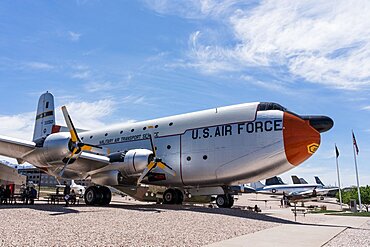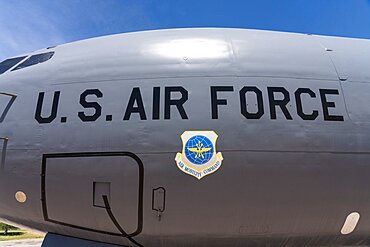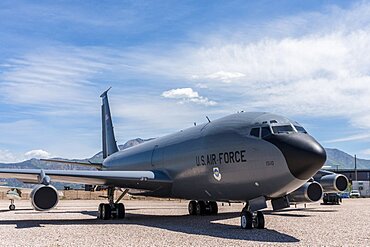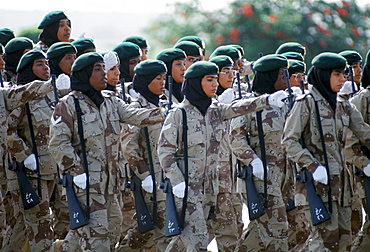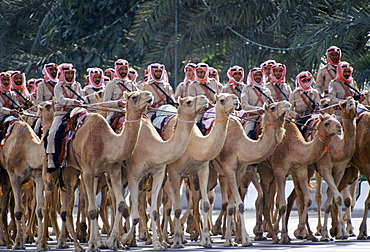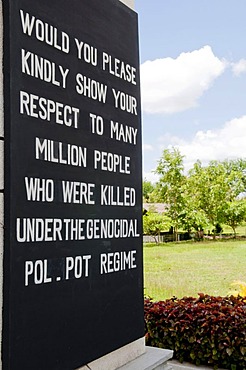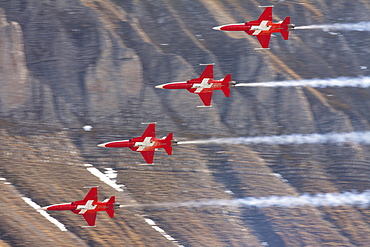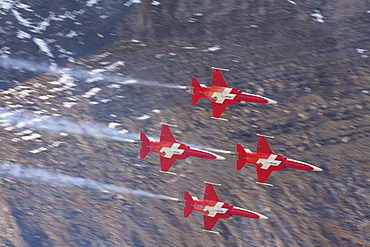Recent searches
Loading...
1350-4077 - A Boeing B-29 Superfortress stategic heavy bomber from WWII in the Hill Aerospace Museum in Utah.
1350-4066 - The Douglas C-124 Globemaster II was the primary heavy-lift transport for the U.S. Air Force in the the 1950's and 1960's.
1350-4070 - The Air Mobility Command insignia on a Boeing KC-135 Stratotanker air refueling tanker in the Hill Aerospace Museum.
1350-4073 - A Boeing KC-135 Stratotanker air refueling tanker in the Hill Aerospace Museum.
1350-4072 - A Boeing KC-135 Stratotanker air refueling tanker in the Hill Aerospace Museum.
1350-4062 - The Vought YA-7F Strikefighter was a transonic prototype strike fighter meant to replace the A-7 Corsair II.
1350-4067 - A North American T-28B Trojan training aircraft from the 1950s in the Hill Aerospace Museum.
1350-4082 - The Douglas C-124 Globemaster II was the primary heavy-lift transport for the U.S. Air Force in the the 1950's and 1960's.
1350-4078 - A Lockheed C-130 Hercules military transport aircraft in the Hill Aerospace Museum in Utah.
1350-4081 - The Douglas C-124 Globemaster II was the primary heavy-lift transport for the U.S. Air Force in the the 1950's and 1960's.
1350-4080 - A Rockwell B-1 Lancer supersonic strategic bomber at the Hill Aerospace Museum in Utah.
1350-4079 - A McDonnell Douglas F-4 Phantom II fighter jet in the HIll Aerospace Museum in Utah.
1350-4074 - A Northrop SM-62 Snark ground-launched nuclear cruise missile in the Hill Aerospace Museum
1350-4076 - A Boeing B-29 Superfortress stategic heavy bomber from WWII in the Hill Aerospace Museum in Utah.
1350-4063 - The Douglas C-124 Globemaster II was the primary heavy-lift transport for the U.S. Air Force in the the 1950's and 1960's.
1350-4071 - Nose art on a Boeing KC-135 Stratotanker air refueling tanker in the Hill Aerospace Museum.
1350-4075 - A Boeing B-52 Stratofortress strategic heavy bomber in the Hill Aerospace Museum in Utah.
858-1 - Camel race during the Desert Festival, Jaisalmer, India
832-355527 - Museum of national history, Bishkek (Frunse), Kyrgyzstan
832-263495 - Typhoon eurofighter, German Airforce multi-purpose fighter plane in flight, airshow, ILA 2008, International Air Display, Berlin, Germany, Europe
832-263516 - Eurofighter Typhoon, German Airforce multi-purpose fighter jet in flight, airshow, ILA 2008, International Aviation Exhibition, Berlin, germany, Europe
1161-7283 - Ceremonial guard at military display at the Sultan's Palace in Brunei Darussalam
1161-5457 - RAF Falcons freefall parachute team taking part in air display at RAF Brize Norton Air Base, UK
1161-7222 - Female armed soldiers parade in camouflage uniform in Abu Dhabi for celebration of 20th Anniversary of United Arab Emirates
1161-7284 - Ceremonial guard at military display at the Sultan's Palace in Brunei Darussalam
1161-7221 - Armed soldiers parade in ceremonial uniform in Abu Dhabi
1161-7244 - Australian warship and crew take part in Naval Review and maritime parade in Sydney Harbour for Australia's Bicentenary, 1988
1161-7236 - Cavalry soldiers riding camels, Abu Dhabi for celebration of 20th Anniversary of United Arab Emirates
1161-7243 - Australian warship and crew take part in Naval Review and maritime parade in Sydney Harbour for Australia's Bicentenary, 1988
1161-5459 - RAF Falcons freefall parachute team taking part in air display at RAF Brize Norton Air Base, UK
1161-7829 - Military display in Kuala Lumpur, Malaysia
1161-7245 - Australian warship and crew take part in Naval Review and maritime parade in Sydney Harbour for Australia's Bicentenary, 1988
1161-5458 - RAF Falcons freefall parachute team taking part in air display at RAF Brize Norton Air Base, UK
1161-7239 - Female armed soldiers parade in camouflage uniform in Abu Dhabi for celebration of 20th Anniversary of United Arab Emirates
1161-5456 - RAF Falcons freefall parachute team taking part in air display at RAF Brize Norton Air Base, UK
1161-1748 - Chelsea Pensioners - the Corps of war veterans cared for at the Royal Hospital in Chelsea and known for their distinctive red uniforms and tricorn hats. They proudly display their medals won for valour.
1161-2510 - British Parachutists on the 50th anniversary of the Battle of Arnhem, Ginkel Heide, Netherlands.
1161-2511 - British Parachutists on 50th anniversary of Battle of Arnhem, Ginkel Heide, Netherlands.
1161-2936 - Chinook helicopter lifts a tank at display given by the 5th Airborne Brigade at Salisbury Plain, Wiltshire, UK
1161-2215 - Military Display, Tidworth, Hampshire, United Kingdom.
832-198534 - The Eurofighter Typhoon at the Airpower 2009 in Zeltweg, Styria, Austria, Europe
832-198530 - Aerobatics team, Turkish Stars, Northrop NF-5A Freedom Fighter B, Turkey, Airpower 2009 in Zeltweg, Styria, Austria, Europe
832-193603 - New monument to victims of German Nazi military courts, inaugurated on 1st Sept. 2009, Cologne, North Rhine-Westphalia, Germany, Europe
832-193605 - New monument to victims of German Nazi military courts, inaugurated on 1st Sept. 2009, Cologne, North Rhine-Westphalia, Germany, Europe
832-155042 - Killing Fields, Phnom Penh, Cambodia, Southeast Asia, Asia
832-124527 - Vintage aircraft, North American T 6 Harvard, Breitscheid Airshow 2010, Hesse, Germany, Europe
832-124528 - MIL MI-24 Hind, Russian attack helicopter from the Hungarian Air Force painted like an eagle, Breitscheid Airshow 2010, Hesse, Germany, Europe
832-124522 - Vintage aircraft, Yakovlev Yak 52, Breitscheid Airshow 2010, Hesse, Germany, Europe
832-124520 - Vintage aircraft, Antonov AN-2, the largest single engine biplane in the world, Breitscheid Airshow 2010, Hesse, Germany, Europe
832-124517 - Vintage aircraft, Antonov AN-2, the largest single engine biplane in the world, Breitscheid Airshow 2010, Hesse, Germany, Europe
832-124521 - Vintage biplane, Boeing Stearman, Breitscheid Airshow 2010, Hesse, Germany, Europe
832-124526 - Vintage biplane, Boeing Stearman, Breitscheid Airshow 2010, Hesse, Germany, Europe
832-124518 - Vintage biplane, Boeing Stearman, Breitscheid Airshow 2010, Hesse, Germany, Europe
832-124513 - Vintage biplane, Boeing Stearman, U.S. Air Force training aircraft, Breitscheid Airshow 2010, Hesse, Germany, Europe
832-124519 - Vintage biplane, Focke Wulf FW-44, Breitscheid Airshow 2010, Hesse, Germany, Europe
832-124514 - Vintage aircraft, Yakovlev Yak 9, warplane of the Soviet Air Force from the second World War, Breitscheid Airshow 2010, Hesse, Germany, Europe
832-124529 - Vintage aircraft, Yakovlev Yak 52, Breitscheid Airshow 2010, Hesse, Germany, Europe
832-124523 - Vintage aircraft, North American Harvard T 6, Breitscheid Airshow 2010, Hesse, Germany, Europe
832-124524 - Vintage aircraft, North American Harvard T 6, Breitscheid Airshow 2010, Hesse, Germany, Europe
832-124516 - Vintage aircraft, Yakovlev Yak 52, Breitscheid Airshow 2010, Hesse, Germany, Europe
832-107789 - Formation flight of the Patrouille Suisse in the Northrop F-5E Tiger II, mountain-air show of the Swiss Air Force at Axalp, Ebenfluh, Interlaken, Bern, Switzerland, Europe
832-107792 - Formation flight of the Patrouille Suisse in the Northrop F-5E Tiger II, mountain-air show of the Swiss Air Force at Axalp, Ebenfluh, Interlaken, Bern, Switzerland, Europe
832-65207 - German biplane, Focke-Wulf Fw 44, first flight in 1932, Europe's largest meeting of vintage aircraft in Hahnweide, Kirchheim-Teck, Baden-Wuerttemberg, Germany, Europe
829-1804 - Tanks on display at the Military Museum in Kalemegdan castle in Belgrade, Serbia, Europe
1116-13665 - Photos of victims of the Military Dictatorship (1973-1990) on display in the Museo de la Memoria y de los Derechos Humanos (Remembrance and Human Rights Museum), Santiago, Región Metropolitana, Chile
857-31805 - Campesinos wash for market freshly-picked carrots in a river in Los Negros, Bolivia Friday, Nov. 12, 2004. Ernesto "Che" Guevara was captured by the Bolivian army in 1967 in a nearby valley and executed in La Higuera days later. His body was put on public display in the laundry room of the Vallegrande hospital, then secretly buried under the air strip for 30 years. Guevara and fellow communist guerillas were attempting to launch a continent-wide revolution modeled on Guevara's success in Cuba in the late 1950s. The Bolivian government recently began promoting the area where he fought, was captured, killed and burried for 30 years as the "Ruta del Che," or Che's Route.
857-31820 - Vendors sell their wares at a street market in El Torno, Bolivia Friday, Nov. 12, 2004. Ernesto "Che" Guevara was captured by the Bolivian army in 1967 in a nearby valley and executed in La Higuera days later. His body was put on public display in the laundry room of the Vallegrande hospital, then secretly buried under the air strip for 30 years. Guevara and fellow communist guerillas were attempting to launch a continent-wide revolution modeled on Guevara's success in Cuba in the late 1950s. The Bolivian government recently began promoting the area where he fought, was captured, killed and burried for 30 years as the "Ruta del Che," or Che's Route.
817-262539 - Ammunition boxes, Transportation Museum of China, Burma, India Theater in World War II, Yunnanyi, Yunnan Province, China
733-3460 - Tanks on display at the Museum of the Great Patriotic War, Kiev, Ukraine, Europe
733-3459 - Tanks on display and Rodina Mat monument, Museum of the Great Patriotic War, Kiev, Ukraine, Europe
You reached the end of search results

